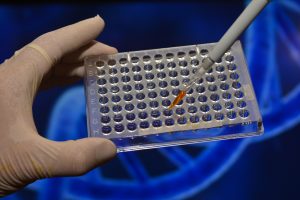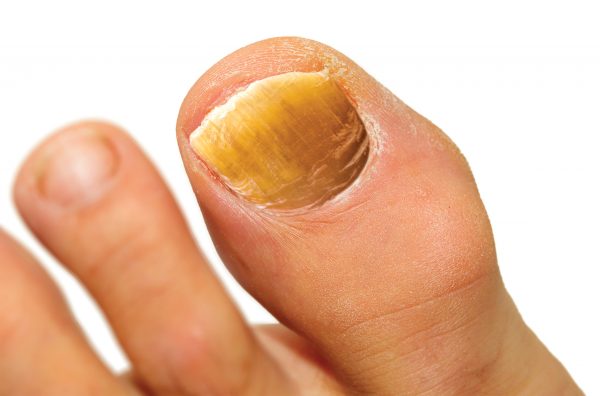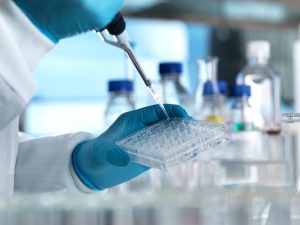What you need to know about PCR Testing
Polymerase Chain Reaction (PCR) testing is a laboratory technique used to detect and amplify small amounts of DNA from a sample. It uses a process of repeated heating and cooling cycles to rapidly multiply the target DNA sequence, allowing it to be detected and analyzed. PCR testing is frequently used for medical diagnosis, forensics, and in biotechnology research. It is also used to detect the presence of specific pathogens such as viruses, bacteria, and fungi.

Laboratory testing is key in getting a definitive diagnosis. PCR testing is a laboratory technique used to analyze and amplify a specific sequence of DNA. It is widely used for a variety of applications, including the diagnosis of genetic diseases, the identification of bacteria and viruses, and the analysis of gene expression. When it comes to nail treatments, PCR can specifically identify the disease-causing organisms. It is important to ask clinicians for lab analysis, so the most appropriate treatment can be used according to the laboratory test results.
PCR is highly sensitive and can be used to detect even tiny amounts of genetic material, making it an invaluable tool for clinicians. It can be used to quickly and accurately identify the presence of a particular gene or organism in a sample, allowing for more efficient diagnosis and treatment.
PCR Testing = Accurate Results.
Early identification of nail disease through PCR testing helps identify proper treatment and prevent complications.
When should I use PCR testing for nails?
- When you suspect fungal infection, such as onychomycosis
- After other methods of diagnosis, such as visual inspection
- When you need more accurate results
- PCR results can be ready within 24 hours
Why do insurance carriers cover PCR testing?
PCR testing is a valuable tool for diagnosing and monitoring the spread of infectious diseases, such as COVID-19 and nail fungal infections such as onychomycosis. As such, most health insurance providers do cover PCR testing under their health plans, as it is an important part of preventing and treating illnesses. Insurance coverage for PCR testing is typically intended to reduce the financial burden of the test, making it more accessible to those who need it. In addition, many insurance plans provide coverage for PCR testing in order to ensure that individuals receive the most accurate diagnosis possible and are able to access timely treatment.
Various nail disorders appear identical, which makes physical examination alone less reliable. Often, nail dystrophy can have more than one cause.
Common Nail Disorders & Changes in Appearance

Infectious Causes
Several organisms can invade the nail unit resulting in infection, including fungi, mold, yeast, or bacteria. Onychomycosis is the medical term for fungal nail infections.
When infected, nails may begin to have visible changes, including discoloration, thickening, or brittle/crumbly texture. Bacterial infections can result in swelling, pain, abscess formation, or green/black discoloration of the nail.
Non-infectious Causes
Eczematous dermatitis, psoriasis, and other forms of dermatitis can affect the health and appearance of the nail. Changes may include lines/ridges, pitting of the nail. or growth irregularities like thickening and splitting of the nail plate. It is also possible to develop cancers in the nail unit, including melanoma, which could cause dark linear streaks or disruption of nail growth.
Trauma to the Nail
Changes in the nail may also be caused by chronic microtrauma. Common microtrauma includes poorly fitting shoes, biomechanical stresses and structural disorders like hammertoes or hallux rigidus, or traumatic injury to the toe.
Causative infectious organisms are colorless and invisible to the eye. Diagnostic testing helps your doctor determine the exact underlying causes of nail disease.
How do I Get the Right Diagnosis?

Ask Your Physician
Your physician determines the cause of your nail disorder by examining the nail in the office, obtaining your medical history, and confirming the clinical diagnosis with laboratory testing, including PCR testing.
Laboratory Testing Basics
Laboratory Testing Basics
A small sample of the nail is taken in the physician’s office and sent to a specialized dermatopathology laboratory for analysis. The lab offers multiple testing options including:
- Microbiologic culture
- Histologic (microscopic) evaluation to determine trauma or infection
- PCR (DNA) analysis for identification of specific infectious organisms
When used in combination, histologic and PCR testing provides the complete picture of your nail disease in 1-2 days.
Your Diagnostic Lab Report
After receiving your specimen, the laboratory will analyze it then provide your physician with a new diagnostic report.
The specialized report contains detailed findings and will help your physician understand the exact cause and find the appropriate treatment.
Targeted treatment for your nail disease begins with a definitive diagnosis through laboratory testing. Ask your doctor about BakoDx nail testing.
What Are My Treatment Options?

Treatment options for onychodystrophy include:
- Oral prescription medications
- Over-the-counter therapies
- Topical treatments
- Laser treatments
- Surgery
Bako Diagnostics is the premier provider of diagnostic services focusing on the nail, skin, soft tissue and bone of the lower extremity. Our pathology team provides both the information and the intelligence to enable patient care.
Visit BakoDx.com to learn more about our podiatry-related pathology services.
DISCLAIMER: THIS WEBSITE DOES NOT PROVIDE MEDICAL ADVICE
The information, including but not limited to, text, graphics, images and other material contained on this website are for informational purposes only. No material on this site is intended to be a substitute for professional medical advice, diagnosis or treatment. Always seek the advice of your physician or other qualified health care provider with any questions you may have regarding a medical condition or treatment and before undertaking a new health care regimen, and never disregard professional medical advice or delay in seeking it because of something you have read on this website. The information contained within this page should be used at a physician’s discretion. Bako Diagnostics assumes no liability for its content.
